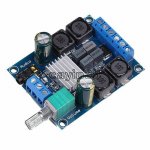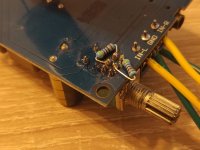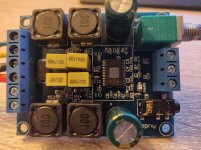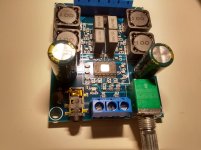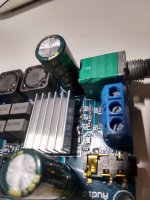Hi safa, we continue after your exam. Good luck with your exam!
okay, thank you very much sir...
Received last week from eBay.
Official Version Finished TPA3116D2 50Wx2 Stereo Digital Power Amplifier Board 664072567238 | eBay
I prefer this module of the TPA3116D2 to the other 2 I have with pots (hissy). This and the blue/black module have more body, better balanced and digs deeper.... just sounds better and with a quiet background.
These are the 2 with pots and the first is not as well built, doesn't have Nichicon caps as in the pic, both caps are different and the pot switch is iffy. The second one is better built but no better in sound IMO.
There are tons out there but it's a lottery on which one to pick that's why this thread is valuable.
I recently got the board on the left, and I'm also struggling with hissing. I followed the guide on http://www.diybudgetaudio.com/TPA3116.htm . I installed a decoupling cap and two 4.7kOhm resistors over the pot, but I am still experiencing hissing at medium volumes (goes away at full or low volume). Any other things I could try to get rid of the noise?
I recently got the board on the left, and I'm also struggling with hissing. I followed the guide on http://www.diybudgetaudio.com/TPA3116.htm . I installed a decoupling cap and two 4.7kOhm resistors over the pot, but I am still experiencing hissing at medium volumes (goes away at full or low volume). Any other things I could try to get rid of the noise?
The 4.7KOhm were connected between the potentiometer mid terminals and the potentiometer ground terminals (the one with direct connection to the supply "-")?
The Ebay site does no longer show the board. Could you please provide us with another photo? Eventually, also a photo of how you installed the 4K7 resistors.
If that does not work, the other modification is to reduce the TPA3116 gain. Often all you need to do is remove one SMD resistor. The problem may be if you can get access to that resistor.
Last edited:
Hi, I've got 2 new XH-542s.
Hooked one up to a 23V supply from a boost converter (checked voltage, ripple and current limiting, no problem with it)running from a 12V Li-Ion battery and it began poping through the speaker (tried swapping it, no luck) at like 1hz as it was being turned on and off continously.
I checked with a cheap oscilloscope the output (MONO output).
It was being pulsed up and after about 200ms down, pulses between roughly +2v -0.5.
Checked output impedeance to vcc, everyting in the Mohm range.
Between pops clean audio comes through and sometimes (rarely) it stabilizes and works without pops.
I tried to power it up directly with the battery but nothing changed.
The same thing happens with the other one.
Is there any hope of getting them working?
Hooked one up to a 23V supply from a boost converter (checked voltage, ripple and current limiting, no problem with it)running from a 12V Li-Ion battery and it began poping through the speaker (tried swapping it, no luck) at like 1hz as it was being turned on and off continously.
I checked with a cheap oscilloscope the output (MONO output).
It was being pulsed up and after about 200ms down, pulses between roughly +2v -0.5.
Checked output impedeance to vcc, everyting in the Mohm range.
Between pops clean audio comes through and sometimes (rarely) it stabilizes and works without pops.
I tried to power it up directly with the battery but nothing changed.
The same thing happens with the other one.
Is there any hope of getting them working?
Last edited:
Hi, I've got 2 new XH-542s.
Hooked one up to a 23V supply from a boost converter (checked voltage, ripple and current limiting, no problem with it)running from a 12V Li-Ion battery and it began poping through the speaker (tried swapping it, no luck) at like 1hz as it was being turned on and off continously.
I checked with a cheap oscilloscope the output (MONO output).
It was being pulsed up and after about 200ms down, pulses between roughly +2v -0.5.
Checked output impedeance to vcc, everyting in the Mohm range.
Between pops clean audio comes through and sometimes (rarely) it stabilizes and works without pops.
I tried to power it up directly with the battery but nothing changed.
The same thing happens with the other one.
Is there any hope of getting them working?
There is always room for hope, if it is realistic time will show. 😀
If both channels work occasionally, the output stage is not burned as such. The way to proceed is to use the amplifier in a situation where nothing prevents the chip from functioning correctly. When that works, we make the operational conditions more severe.
Would you have a kind of DC power supply (not batteries as they can be deceptive) with a voltage between 9V and 20V and a current of minimum 1A?
Do you have a small table fan you can use to cool the amplifier?
Last edited:
The 4.7KOhm were connected between the potentiometer mid terminals and the potentiometer ground terminals (the one with direct connection to the supply "-")?
The Ebay site does no longer show the board. Could you please provide us with another photo? Eventually, also a photo of how you installed the 4K7 resistors.
If that does not work, the other modification is to reduce the TPA3116 gain. Often all you need to do is remove one SMD resistor. The problem may be if you can get access to that resistor.
I included a picture from the ebay listing and the way I installed the resistors:
Attachments
I included a picture from the ebay listing and the way I installed the resistors:
I have that board. Strange, on my board it worked, on yours not. The heatsink is glued on the chip and unfortunately often difficult to remove. If you cannot remove the heatsink you have little access to the resistors.
Try gently to twist the heatsink (don't pull upwards!) to see if the heatsink can be removed. The danger is that the PCB tracks may get loose.
The 4K7 resistors seem correctly mounted. No improvement on any of the two channels?
the heat sinks come loose and then are stuck on with the double sided tape on these boards. getting the right SMD should be possible before sticking on the heat sink!
I have around 5 of the same board. they all hiss. Which SMD resistor affects gain now?
Hi Jared,
Could you please send me a photo (close up) of the chip and the resistors around?
Hi Jared,
Could you please send me a photo (close up) of the chip and the resistors around?
If it's the same board:
Attachments
It looks the same except the caps are blue on mine I think, not yellow. I will snap a pic tonight. I also modded one to be mono with instructions much earlier in this thread actually. I can take some pics of that one too I guess.
Many thanks for the photo, Deosneos. You managed well to remove the heatsink.
R4 and R5 are the gain setting resistors. There seems to be a problem at least on Deosneos board that could cause the hiss.
I found my own board, removed the heatsink and read R4=”104”=100K, R5+”393”=39K. That corresponds to “Master” 32dB gain according to the TPA3116 datasheet ( http://www.ti.com/lit/ds/symlink/tpa3116d2.pdf ), Table 1 on page 14. Fine.
When I read the values on Deosneos’ board, I believe I see R4=”010”=1 Ohm, R5=”39x”=?. The “x” I cannot read.
Deosneos, can you please read the values for R4 and R5 on your board?
Jared, can you please read the values for R4 and R5 on your board?
R4 and R5 are the gain setting resistors. There seems to be a problem at least on Deosneos board that could cause the hiss.
I found my own board, removed the heatsink and read R4=”104”=100K, R5+”393”=39K. That corresponds to “Master” 32dB gain according to the TPA3116 datasheet ( http://www.ti.com/lit/ds/symlink/tpa3116d2.pdf ), Table 1 on page 14. Fine.
When I read the values on Deosneos’ board, I believe I see R4=”010”=1 Ohm, R5=”39x”=?. The “x” I cannot read.
Deosneos, can you please read the values for R4 and R5 on your board?
Jared, can you please read the values for R4 and R5 on your board?
I have to specify that my board is in MONO configuration.There is always room for hope, if it is realistic time will show. 😀
If both channels work occasionally, the output stage is not burned as such. The way to proceed is to use the amplifier in a situation where nothing prevents the chip from functioning correctly. When that works, we make the operational conditions more severe.
Would you have a kind of DC power supply (not batteries as they can be deceptive) with a voltage between 9V and 20V and a current of minimum 1A?
Do you have a small table fan you can use to cool the amplifier?
I'll try with a 12v psu and a fan although the heatsink stays cool.
I have to specify that my board is in MONO configuration.
I'll try with a 12v psu and a fan although the heatsink stays cool.
It is important that you try for some 10 minutes with music having little bass and only at a moderate sound level.
I have the XH-M542 as well. Two, and they work. Are yours with a glued or a screwed heatsink? The reason why I ask is that I have seen more TPA3116 boards with a flawed setup as clock "slave" which may give problems.
Last edited:
I used one for about a year in a portable 100w speaker before a cascade failure starting with a blown tweeter, then amp and bluethooth module (high voltage feedback on audio line teminals?)It is important that you try for some 10 minutes with music having little bass and only at a moderate sound level.
I have the XH-M542 as well. Two, and they work. Are yours with a glued or a screwed heatsink? The reason why I ask is that I have seen more TPA3116 boards with a flawed setup as clock "slave" which may give problems.
I tried with a fan and a 12v psu, powered it up: popping. Very low music>popping. Medium music, after a few second>normal and then again popping with no way of recovering.
Mine is glued the previous one that I used in the speaker was also glued.
Thanks for your assistance.
I used one for about a year in a portable 100w speaker before a cascade failure starting with a blown tweeter, then amp and bluethooth module (high voltage feedback on audio line teminals?)
I tried with a fan and a 12v psu, powered it up: popping. Very low music>popping. Medium music, after a few second>normal and then again popping with no way of recovering.
Mine is glued the previous one that I used in the speaker was also glued.
Thanks for your assistance.
If your amplifier has been working well and stably for a long period of time, there is an accident of more important kind and afterwards the amplifier does systematically not function well and stably, it is very likely the chip has suffered damage from the accident. The chip can be replaced but it is often not worth the effort and cost.
For those of you with glued heatsinks, if it’s the silicone thermal adhesive you can cut it with some dental floss, worked for me with my 2 douk audio 3116’s
Turns out this cell phone camera sucks compared to last phone.
The amp with heatsink I converted to mono so the caps are shorted. One of the caps had fallen off the board entirely so it is stuck back down poorly as well. The first pic is the last of the 5 or so I have that I had not stuck the heatsink down on. So it looks like the same defect as the other board.
looks like for mine:
R1 222
R2 222
R3 393
R4 010
R5 393
The amp with heatsink I converted to mono so the caps are shorted. One of the caps had fallen off the board entirely so it is stuck back down poorly as well. The first pic is the last of the 5 or so I have that I had not stuck the heatsink down on. So it looks like the same defect as the other board.
looks like for mine:
R1 222
R2 222
R3 393
R4 010
R5 393
Attachments
Last edited:
The amp that was in the portable speaker is officially dead.If your amplifier has been working well and stably for a long period of time, there is an accident of more important kind and afterwards the amplifier does systematically not function well and stably, it is very likely the chip has suffered damage from the accident. The chip can be replaced but it is often not worth the effort and cost.
The one I'm talking about, the one with pops, is a new one.
- Home
- Amplifiers
- Class D
- TPA3116D2 Amp
